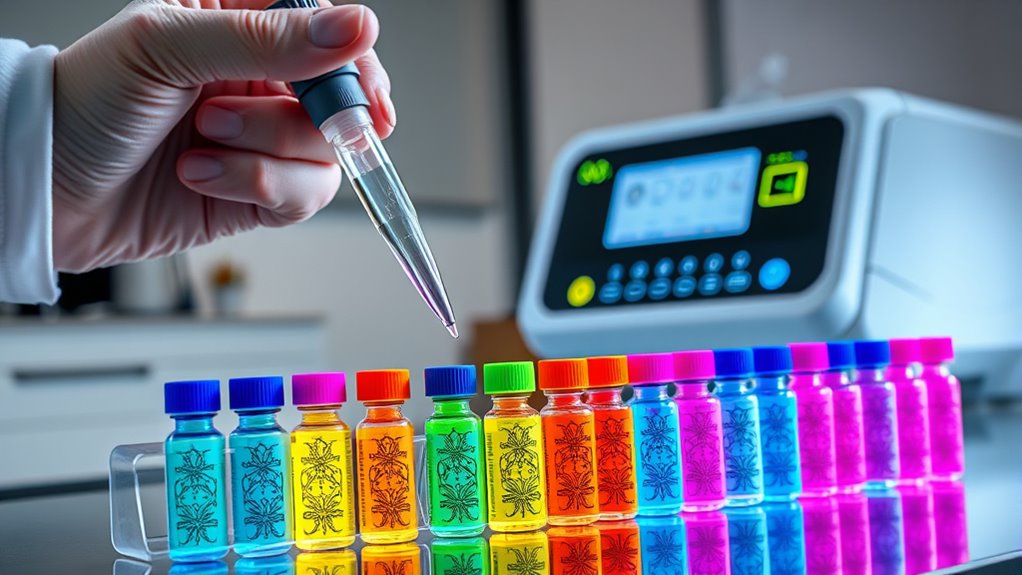When choosing next-generation primers, focus on their melting temperature, GC content, and specificity to target your sequence. Opt for designs that minimize secondary structures and primer-dimers, ensuring efficient amplification. Consider advanced chemistries or modifications for challenging templates. Using well-designed primers improves sensitivity, reduces off-target effects, and increases reproducibility. If you want to optimize your experiments further, you’ll find valuable insights if you keep exploring these best practices.
Key Takeaways
- Select primers with optimal Tm, GC content, and minimal secondary structures tailored to your target sequence.
- Consider incorporating chemical modifications to enhance stability, specificity, and performance in challenging templates.
- Use primer design software or advanced platforms that utilize next-generation chemistry for precise customization.
- Validate primer efficiency through test PCRs, ensuring consistent amplification and minimal off-target effects.
- Maintain proper storage conditions and quality controls for reliable, long-term use of next-generation primers.

Have you ever wondered how next-generation primers can revolutionize your molecular biology experiments? These advanced tools are transforming the way you approach DNA amplification, making processes faster, more accurate, and highly reliable. The key to harnessing their full potential lies in effective primer design. When designing primers, you need to focus on factors like melting temperature (Tm), GC content, primer length, and the avoidance of secondary structures or primer-dimer formations. Proper primer design ensures that your primers bind specifically to the target sequence, reducing off-target amplification and improving overall results. With next-generation primers, you can fine-tune these parameters more precisely, leading to better amplification efficiency.
Next-generation primers enable precise design, boosting amplification efficiency and specificity for more reliable molecular biology results.
Amplification efficiency is critical because it directly influences the sensitivity and accuracy of your PCR results. Next-generation primers are crafted with enhanced chemistry and structure, allowing for higher binding affinity and more consistent performance across a broad range of conditions. These primers often incorporate modifications that increase stability and reduce the likelihood of mismatches or non-specific binding. As a result, you’ll notice a significant boost in amplification efficiency, meaning you can achieve clearer, more robust signals even from low-abundance templates. This heightened efficiency not only speeds up your experiments but also minimizes the need for extensive optimization, saving you valuable time and resources.
When selecting primers for your experiments, consider the context and purpose of your work. For example, if you’re targeting a gene with high GC content or complex secondary structures, next-generation primers are designed to handle these challenges more effectively. They often feature optimized sequences that promote consistent annealing, ensuring your target DNA is amplified with minimal bias. Additionally, these primers tend to have improved tolerance to variations in reaction conditions, making them versatile for different experimental setups. This consistency in performance directly translates into higher reproducibility and reliability, which are essential in research and diagnostic applications.
Using next-generation primers also simplifies troubleshooting. Since they’re engineered for optimal performance, issues like primer-dimer formation or nonspecific products become less common. This results in cleaner PCR results and easier interpretation of your data. Moreover, many next-generation primers come with integrated quality controls and advanced chemistries that enhance their stability and shelf life, so you can rely on their performance over time. Overall, by paying close attention to primer design and choosing high-quality next-generation primers, you set a solid foundation for successful amplification and dependable results.
Frequently Asked Questions
How Do Next-Generation Primers Improve Specificity Compared to Traditional Primers?
Next-generation primers improve specificity through primer modification, which reduces non-specific binding, and by optimizing melting temperature, ensuring primers bind only to the exact target sequence. These primers are designed to have precise melting temperatures, allowing for more accurate annealing during PCR. As a result, you get fewer off-target amplifications, enhancing the reliability of your results. This combination of primer modification and melting temperature control makes next-generation primers more specific than traditional ones.
What Are Common Challenges in Designing Next-Generation Primers?
Primers pose particular problems, especially when designing next-generation primers. You’ll struggle with primer dimer formation, which can sabotage your results, and balancing GC content, since too high or low GC levels cause instability. To overcome these challenges, you need to guarantee primer length, avoid complementary sequences, and carefully control GC content. Staying vigilant against these pitfalls ensures your primers perform perfectly, providing precise, reliable amplification every time.
How Can I Troubleshoot Issues With Primer Binding Efficiency?
To troubleshoot primer binding efficiency, you should first run gel electrophoresis to check your PCR products’ size and quantity. If amplification is weak, optimize the annealing temperature—try increasing or decreasing it in small steps to find the most suitable condition. Also, make sure your primers are specific and free of secondary structures. Adjusting these parameters helps improve binding efficiency and overall PCR success.
Are There Specific Tools Recommended for Designing Next-Generation Primers?
You should use specialized software tools like Primer3, NCBI Primer-BLAST, or Geneious for designing next-generation primers. These tools incorporate advanced design algorithms that help optimize primer specificity, melting temperature, and secondary structures. They streamline the process, reduce errors, and guarantee your primers are well-suited for high-throughput sequencing or other next-generation applications. Always verify your designs with in silico analyses before synthesis to save time and improve success rates.
How Do I Validate the Performance of Newly Designed Primers?
Think of primer performance validation as testing a new recipe before serving it to guests. To guarantee your primers work effectively, you should run validation techniques like PCR amplification, melt curve analysis, and sequencing. These methods help check specificity, efficiency, and accuracy. By carefully analyzing the results, you confirm your primers perform reliably, giving you confidence in your experiments and ensuring your research stands on a solid foundation.
Conclusion
By carefully selecting and using next-generation primers, you can unlock more accurate and efficient results in your research. Imagine discovering a new disease marker faster than ever before, just like a lab team did when they adopted these advanced tools. Your dedication to choosing the right primers can make a real difference, helping you push the boundaries of science and improve lives. Keep experimenting and refining—your breakthroughs are within reach.








